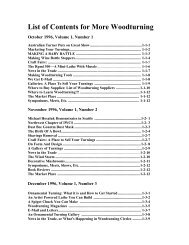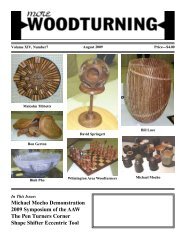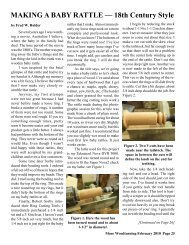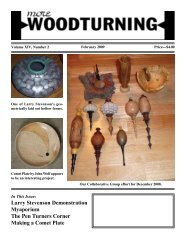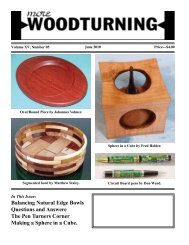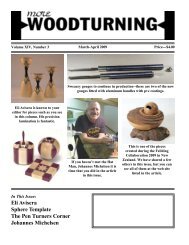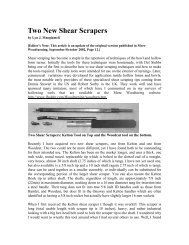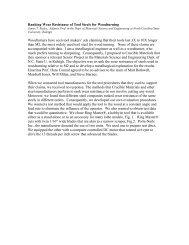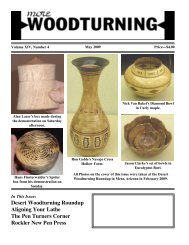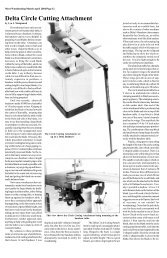Robust Lathe Review - More Woodturning
Robust Lathe Review - More Woodturning
Robust Lathe Review - More Woodturning
Create successful ePaper yourself
Turn your PDF publications into a flip-book with our unique Google optimized e-Paper software.
chuck and had to wait what seemedlike a long time before it came loose,or I had to pull the vacuum hose offat the headstock. Now I could justreach around and open the bleedervalve. (It is important to be able torationalize one’s purchases!)However, the question ofwhether these vacuum pumps didor did not come with check valvesbothered me, so I called all the majorwoodturning catalogs. They didn’tknow, but some thought their Gast®,HoldFast®, or other pumps did notcome with check valves...and theythought the bowl would come offthe chuck “pretty quickly.” No harddata was provided.Next, I called OneWay; theysell a Gast pump, and for $38.00more will supply a check valve.To my surprise none of thewoodturning catalogs I calledseemed up-to-date on the notion ofa check valve to stop bowl fly-off.But, they appreciated my suggestionthat they look into offering one.NES and Air-Vac are two othermajor manufacturers of vacuumpumps; they believed that 99%of such pumps do NOT automaticallycome with check valves,which have to be ordered separately.They recommended a minimum of20inHg for woodturning, and I sawother numbers from 19 to 26.5inHg(inches of mercury); mine is ratedat 26inHg. Atmospheric pressureat sea level is 29.92 inches Hg, bythe way.It would be good to pause andmention that the type of wood beingturned, whether green or cured, itsthickness, and whether finished ornot makes a great impact on vacuumholding. A thin vessel of porouswood may need more CFM (CubicFeet per Minute of air movement)to stay on the chuck. My Precisionpump has a low CFM, I’m told oneCFM, yet it works fine for me; Iusually have the bowl’s interiorand most of the exterior finished(lacquer plus wax and polishing)before vacuum chucking to finishthe bottom. Club member John Hilltried a Gast with 4CFM and nowprefers one with 10CFM, along witha bleeder valve and vacuum gauge.He and club member Gary Billscommented that with “leaky” wood,like Ash, you need a higher CFM tooffset the steady loss of vacuum.John referenced David Lancaster( http://www. heirloombowls.com ) as a long time expert, I calledDavid. A pleasant chat led to hisobservation that if you are turninga large and unfinished bowl youwill get a lot of leakage through thewood and need more CFM; he has3 different Gast pumps and doeslarger bowls. But, he agreed that ifthe wood is finished and there is atight seal, small CFM is all that isneeded. I guess one has to decide onall the variables...type wood, shopspace, funds available, whether tofirst finish the turning, etc....beforemaking up one’s vacuum system.Going back to Precision Medical,and getting to the right experttherein, I learned that my Precisionpump is of a “rocking piston” design,with flapper valves at the pumphead which function as a checkvalve (thus making my new checkvalve a bit redundant). It makessense, in a medical setting, to NOThave bodily fluids that are beingsucked out, to be allowed to flowback in during a power failure.Precision’s expert also advisedthat rebuilding the pump is inexpensive,at around $50.00.Another approach, not exploredherein, is to build your ownvacuum pump; Google somethinglike “make a vacuum pump” andyou will be amazed at the options,a do-it-yourselfer’s field day.<strong>Review</strong>ing what I had learnedI added a micro-filter (20 Micron),vacuum gauge, and some neat hoseclamps, from my local automotivesupply store, that have thumbscrews so no screwdriver is neededto tighten or loosen the clamps.The last picture shows the fullinstallation...jury rigged to just seethat it all works. It is suspended ona long 1” x 3” board screwed to mystudio’s ceiling joists. I’ll make anicer mounted setup one of thesedays. Soon. Perhaps.Such is the reality of experimentation.CONCLUSIONS:1 - Vacuum chucking is a verygood idea.2 - If you turn solid wood, lowCFM is fine.3 - If you finish (seal the pores)the inside of your vessel before reversechucking, low CFM is fine.4- A manual relief bleedervalve allows quicker release of theturning when done, AND allows useof lower vacuum on thin, flexingvessels to avoid bottom bursting.5 - Having a check valve is avery good idea to prevent vessel flyoffdue to power failure. 6 - Havingan extra vacuum storing tank is anotherway to give you “catch” timedue to power failure, AND to allowturning “leaky” wood. If you havethe shop space, a setup like JohnHill’s, Fig. 1, is probably best.A final observation is that Istarted this investigation just thinkingthe issue was preventing vessel[Continued on Page 18]<strong>More</strong> <strong>Woodturning</strong> February 2010 Page 17



